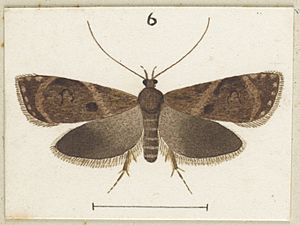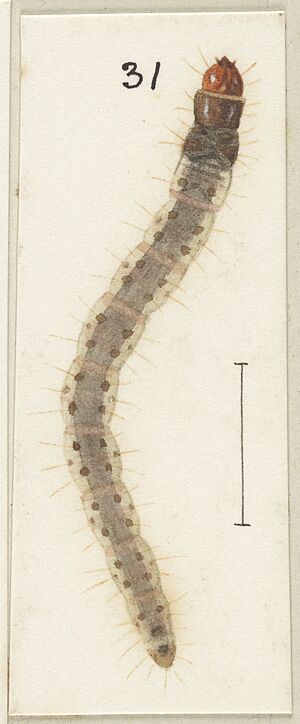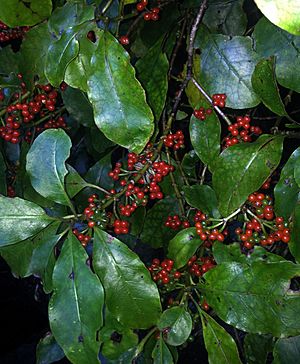Izatha austera facts for kids
Quick facts for kids Izatha austera |
|
|---|---|
 |
|
| Scientific classification | |
| Kingdom: | |
| Phylum: | |
| Class: | |
| Order: | |
| Family: |
Oecophoridae
|
| Genus: | |
| Species: |
I. austera
|
| Binomial name | |
| Izatha austera (Meyrick, 1883)
|
|
| Synonyms | |
|
|
Izatha austera is a type of moth that belongs to the Oecophoridae family. It lives only in New Zealand, meaning it's endemic there. The young moths, called larvae, are like caterpillars. They dig tunnels into dead wood, which is where they find their food. These larvae grow up by September, and the adult moths fly around from December to January. It's not often seen, even though its colors can change a lot.
Contents
Discovering the Izatha austera Moth
The Izatha austera moth was first described by a scientist named Edward Meyrick in 1883. He first wrote a short description, then a more detailed one in 1884. Meyrick found two of these moths in the Botanic Garden and a forest in Wellington during January. The original specimen, called the lectotype, is kept safe at the Natural History Museum, London. Another scientist, George Hudson, also wrote about and drew this moth in 1928.
What Izatha austera Looks Like
Larva Description
The larvae of Izatha austera are a little over half an inch long. They are thin and round. Their head is reddish-brown and shiny. The second part of their body is dark brown and hard. The third part has two brown, hard, triangle-shaped plates on its back.
The rest of their body is a dull yellowish color. It has a wide, dark gray stripe down its back. There are also four bumps on its back that stand out. The very last part of the body is hard and yellowish-brown. Along their sides, they have a line of bumps and a whitish ridge. All these bumps have long, yellowish-brown hairs.
Adult Moth Description
The adult moths have a wingspan of about 13 to 19 millimeters for males. Females are a bit larger, with a wingspan of 16.5 to 25 millimeters. The color of their front wings can vary quite a lot. They also have small tufts of scales on their front wings that you can notice.
These moths can sometimes be mistaken for another moth called I. dasydisca. However, male I. austera moths have blackish antennae. They also have a small tuft of scales on the third part of their labial palp (a mouthpart). Unlike I. dasydisca, they do not have two large tufts of scales on their front wings.
Where Izatha austera Lives
Izatha austera is found only in New Zealand. It is common throughout the North Island. There has been only one sighting recorded in the South Island, in the north-west Nelson area. You can find this moth in many districts. These include Northland, Auckland, Coromandel, Waikato, Bay of Plenty, Taranaki, Taupo, Gisborne, Hawkes Bay, Rangitikei, Wellington, and Nelson.
Life Cycle and Habits
The larvae of this moth live inside silken tubes. These tubes are found under the bark of dead branches of their host plants. The larvae live through the winter months. They become fully grown by the end of September.
Adult moths fly from December to February. Scientists have collected these moths using sugar traps. They also find them by gently shaking shrubs during the day. Izatha austera moths do not often come to lights at night. When an adult moth rests on a bare tree trunk, it is very hard to see. This helps it stay hidden from predators.
Habitat and What it Eats
The larvae of Izatha austera feed on dead wood during the winter. This includes moist logs lying on the forest floor. They also eat drier dead wood that is still standing. They have been found on dead branches of several native New Zealand plants. These include Aristotelia serrata, Coprosma grandifolia, and likely Coprosma robusta. Other plants they feed on are Cordyline australis, Coriaria arborea, Laurelia novae-zelandiae, Litsea calicaris, Melicytus ramiflorus, and Olearia rani.
The larvae tunnel into the wood. As they eat, they produce a lot of frass (which is like sawdust and droppings). This frass is often easy to see on the outside of the branch. Many larvae can often live together in a single branch or log.



